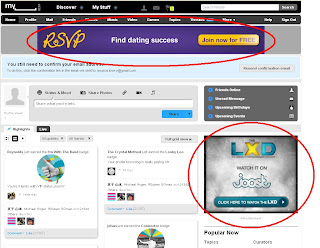At a recent GGDMelb (Girl Geek Dinners Melbourne) we casually discussed digital advertising and many around the room were on opposing views regarding what metrics to track in order to serve up contextual advertising. I ineptly attempted to discribe a video I’d seen on YouTube titled, ‘The Break Up’.
The video was created in 2007 by Microsoft for the company’s Digital Advertising Solutions. An ad for advertisers that illustrates where things are moving. The concept of looking at consumers in a new way deserves our attention.
What if we could go beyond counting hits on a page? What if we could think outside the box treating our customers as individuals rather than stereotypes? What if instead of guessing what a consumer wanted to buy we could ask them and deliver a product that fulfils their expectations?
I think the answer comes from a few leading philosophies- these being: the long tail, permission marketing and more intelligent algorithms. Since we’re no longer looking at websites, but platforms –how can we do better than banner ads and one off promotions? Why are we trying to sell things online like they do on TV? They are not the same media- not even close!
A few years ago I attended NextMedia, a conference in Toronto, Canada that was extremely influential with how I arrived at my current frame of mind regarding Digital Advertising. The first lecture was about marketers learning about word of mouth advertising from the Grateful Dead.
In an article by Gareth Rees reviewing a book on this very subject he attests, “The Grateful Dead knew this as far back as 1965, as David Meerman Scott and Brian Helligan reveal in Marketing Lessons from the Grateful Dead: What Every Business Can Learn from the Most Iconic Band in History. According to the authors: “The Dead pioneered a ‘freemium’ business model, allowing concert attendees to record and trade concert tapes, building a powerful word-of-mouth fan network powered by free music.”
By encouraging fans to share bootleg copies of live events the band was able to reach out to an ever growing audience. The fans felt apart of the legacy and held a sense of duty to share their experience. This is why decisions for regulating digital media are so controversial. By restricting what users can and can’t do with copyright protected media (such as music and movies) companies are restricting fans ability to fully envelop themselves in the brand. Fans want to share not because they want to commit an illegal act, but because they want to go beyond the current limited experience. Quite simply, there is too much control and not enough listening.
So where do we go from here? I believe the answer is in personal recommendations, personalised customisation, transmedia and exclusivity. If a brand can cross multiple forms of media there are more places to sell a niche product which is what consumers are looking to buy. There are lots of examples that prove when a band distributes content for free and diversify their offering they earn more in sales. The authors of Wikinomics, describe prosumption as a non-passive consumer who wants to participate in the creation of products and services. Allowing fans to create their own video clip is only the tip of the iceberg.
Modern advertising is about relationships and that takes time to cultivate. It also takes more time for marketing to be able to create more than one newsletter and more than one special offer. The hardest part is letting go of control and providing tools allowing consumers to take on the role of authority. But the benefits of personalization mean that your brand wins more loyal fans because consumers appreciate being part of a conversation rather then disruptive ads. It’s harder and more time consuming and that’s why businesses don’t try harder to do a better job, but that short-sighted thinking will see their demise in the years to come when competitors sneak up from behind with a more authentic selling proposition.
When you switch your thinking from my website to my platform you'll begin to see that it's not as important to currate content as it is to allow users to customise their own experience. The more you allow a user to create their own content stream the more you'll know about them. The more users rate, review and talk to you about your brand the easier it will be to sell to them. That's the fantastic business model that is Threadless. Stop trying to tell consumers what they want and start listening to them.
So how do you get in front of consumers in the first place? Check out Hunch and Get Glue.






